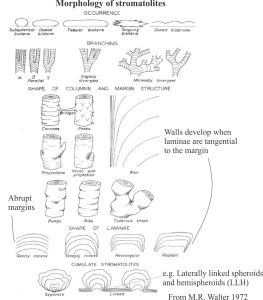A look at stromatolites and cryptalgal laminates in outcrop
This is part of the How To…series on describing sedimentary rocks
Two billion years ago, life was in full swing. Rocks in the Belcher Islands (Hudson Bay, Canada) record some of these ancient life forms, the microorganisms, dominated by prokaryotic cyanobacteria (sometimes called blue-green algae). Careful teasing of the rock record reveals their story, where we see a wonderful array of delicately laminated mats (or cryptalgal laminates), and stromatolites, those architectural delights are preserved as simple domes, complexly branched columns, and even vast, reef-like build-ups. The environments in which they grew ranged from the most landward extent of ocean tides (supratidal) to deeper shelf and platform. Prokaryotic cyanobacteria are mostly photosynthetic organisms meaning that stromatolite growth took place within the photic zone; the water depth limit of modern marine photic zones is about 200m.
All the images here are from Belcher Islands. Al the examples occur in dolostones, where the original carbonate (aragonite, calcite, high magnesium calcite, protodolomite) was replaced by dolomite during early through late burial diagenesis.
The Atlas of Stromatolites and Cryptalgal Laminates contains many more excellent examples.
What is a stromatolite?
Most definitions of usually include the following attributes (Walter, 1972; Bosak et al. 2013, Suosaari et al. 2019):
- They are organosedimentary structures, which means that biological and sedimentary processes are involved in their growth
- Their biological foundations are microbes; prokaryotic cyanobacteria during the Precambrian, with increasingly important contributions from eukaryotes like green and red algae, and phytoplankton such as diatoms during the Phanerozoic.
- They tend to accrete from the sediment-water or substrate interface via trapping of fine sediment and precipitation of carbonate.
- Accretion may be laminar (laminated stromatolites abound in Precambrian rocks), or as diffuse, non-structured or clotted forms known as thrombolites.
Some studies in the 1950s-60s, particularly by Russian geologists (or at that time Soviet geologists), advocated biological controls on stromatolite morphology, conferring biostratigraphic value to Precambrian genera like Inzeria, Conophyton, and Tungussia (an example is shown below). This would indeed have been a happy circumstance, given that most of the Precambrian lacks any other biostratigraphic markers. Unfortunately, with burgeoning interest in stromatolites from the 1970s and on, it became apparent that stromatolite morphology was largely a function of environmental conditions – this is particularly true for high energy environments (e.g. waves and currents in intertidal and shallow subtidal environments), although biological controls may gain in importance in low energy conditions (e.g. deeper subtidal).
Something to keep in mind as you work through these structures
Stromatolites in outcrop commonly appear as columns or domes, in some cases extending vertically several metres. But their sea-floor profiles, or synoptic relief during growth were low. We can visualize this when tracing individual laminae or sets of laminae (ie. the original mat surface) from one column to the next. Your average intertidal, shallow shelf or platform stromatolite extended no more than a few millimeters or centimeters above the sea floor. Some large mounds, or reef-like structures had a few metres relief; but nothing like more recent coral reefs. This also means that the environmental conditions for incremental growth must have been stable for long periods of time (decades to perhaps 1000s of years). This needs to be kept in mind when looking at cryptalgal structures in outcrop; their apparent size can be misleading.
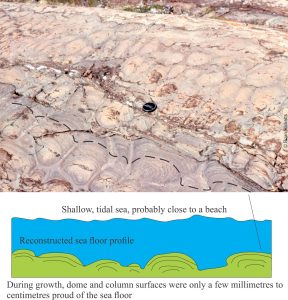

Illustration of synoptic relief on the growing surfaces of domal and bulbous stromatolites. The dashed line traces a single set of laminae across several structures.
Stromatolite morphology
The chart shown here is one of M.R. Walter’s (1972) early categorizations of stromatolite shapes, laminae structure, branching, and ornamentation. There have been a few iterations, but the basic descriptive attributes have not changed.
Associated sedimentary structures
The list includes some of the more common structures in sedimentary facies associated with stromatolitic buildups. Typical environmental indicators are also noted. Phanerozoic stromatolites may be accompanied by benthic, infaunal and epifaunal invertebrates.
- Mud cracks (supratidal to upper intertidal)
- Halite and gypsum, or their pseudomorphs
- Interference ripples (intertidal, flood-ebb tidal flux)
- Lenticular and flaser bedding (intertidal, flood-ebb tidal flux)
- 2D and 3D subaqueous dunes (intertidal to shallow subtidal, tidal channel)
- Ooid shoals (shallow subtidal platform)
- Edgewise conglomerate pavements (intertidal, particularly beach)
- Beachrock (beach)
- Hummocky cross-stratification (typically about storm wave-base)
- Laminated siltstone-mudstone (deeper platform-shelf)
Other useful links in this series
Mineralogy of carbonates: Stromatolite reefs
Sedimentary structures: coarse-grained fluvial
Sedimentary structures: fine-grained fluvial
Sedimentary structures: Mass Transport Deposits
Sedimentary structures: Turbidites
Sedimentary structures: Shallow marine
Describing sedimentary rocks; some basics
Measuring a stratigraphic section
The images


A nice polished surface showing anastomosing and coalescing domal stromatolites, and oncoids that became stabilized, forming the foundations for larger domes. Subtidal, washed by currents and subjected to occasional storms. McLeary Formation.


Large stromatolite domes with low synoptic relief and bridging laminae. Probably deeper subtidal. Mavor Formation.


Exhumed, elongate stromatolite domes on bedding. Stromatolite elongation and orientation is useful for paleocurrent analysis. The intermound muds have been preferentially removed by erosion. Synoptic reliefs here commonly 5-10 cm. Shallow subtidal subjected to wave and current wash. McLeary Formation.
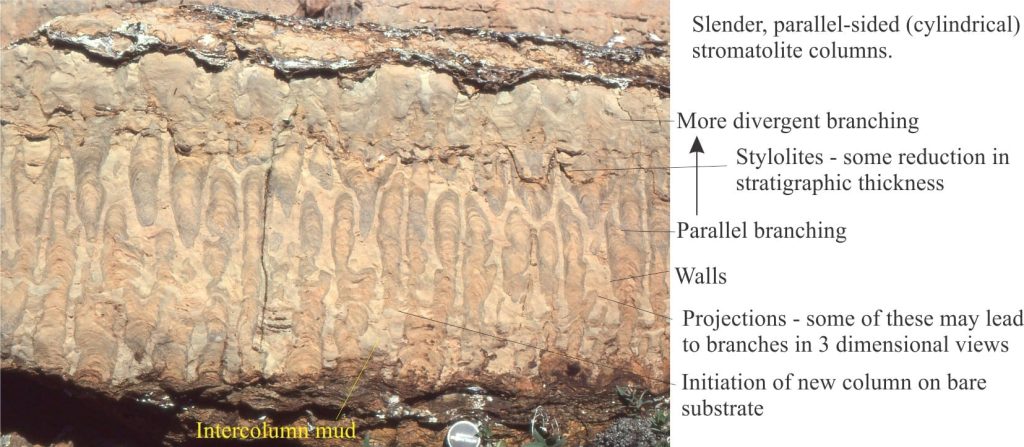

Closely spaced, parallel branched stromatolite columns. Good wall structure, and some ornamentation on the columns. Shallow subtidal, washed by waves. McLeary Formation
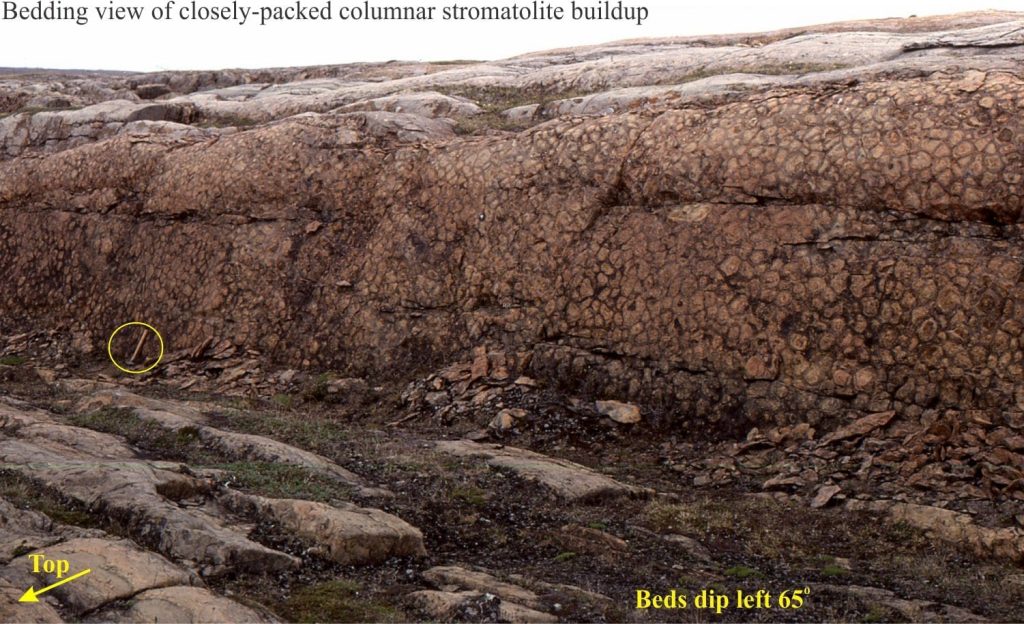

Bedding showing a plan view of densely packed stromatolite columns. This is the same bed as the image of parallel-sided columns shown above. Shallow subtidal, washed by waves. Hammer for scale (circled)
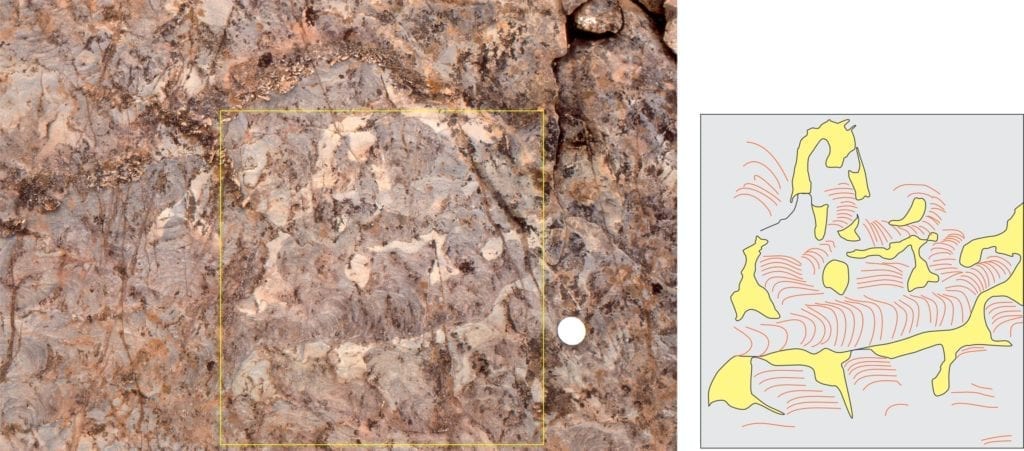

Highly divergent branching typical of the form Tungussia. I have made an attempt to trace the columns and laminae (inset). Mavor Formation. Dolomite recrystallization in this unit has been relatively intense; this tends to obscure the finer structural details


Some really nice microdigitate and wavy-undulating cryptalgal laminates. Scouring interrupted growth at several stages, and also produced mud-mat rip-ups. Mostly intertidal. McLeary Formation
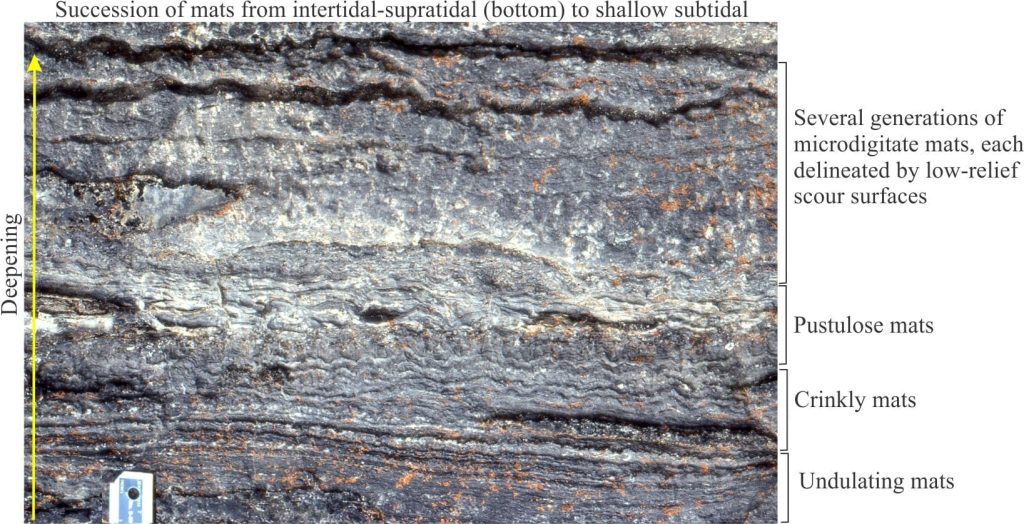

Changing mat morphology, from undulating to wavy, pustulose, and ultimately microdigitate structures, reflecting progressive deepening from supratidal, through intertidal. possibly shallowest subtidal. McLeary Formation. Scale is 3 cm long.


Right image shows traces of some of the growth and erosion surfaces. The sequence begins with simple domes that contain many internal discordances resulting from desiccation and erosion by storms. These morph into digitate columns that grew atop the domes and along their sloping margins. The brown coloured columns have been silicified (resistant); the remainder are dolomite (all in grey hues). Domes and columns are truncated by a major event that left a skinny deposit of cryptalgal mat rip-ups and oncoids in various stages of growth. The topmost layer consists of relatively simple cryptalgal-microbial laminates, but these too contain local erosional discordances. All these events contained within a sequence 38 cm thick. Coin is 19 mm diameter. Kasegalik Fm. Belcher Islands.
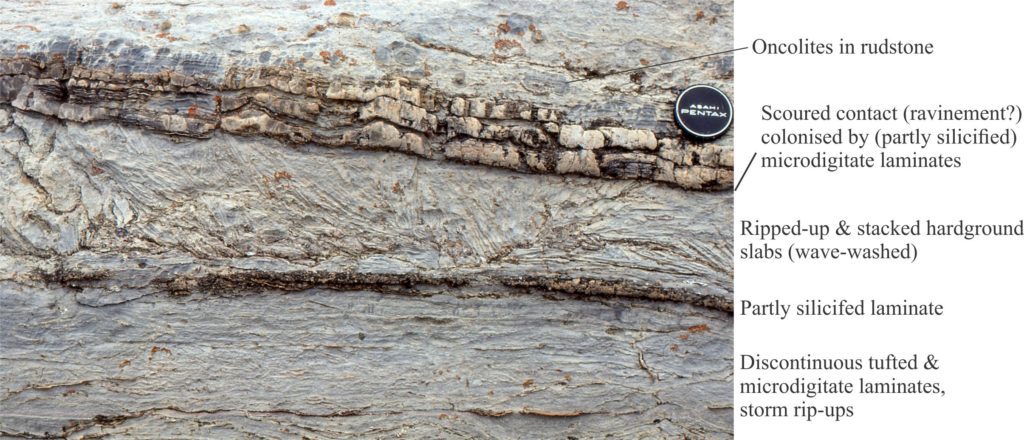

Lots going on in this 40 cm thick interval. In the lower section intertidal-supratidal microbial mats and carbonate mud layers have been disrupted by desiccation and moved around during storm surges. In the middle section, eroded carbonate hardground slabs are stacked edgewise (aka edgewise conglomerate) that in bedding views can be mapped as discontinuous pavements; modern analogues form on relatively high energy beaches. The pavements were later colonised by thin cryptalgal laminates (mats) that contain delicately preserved microdigitate structures – the laminate carbonate here has been partly replaced by silica (chert). Top section is a mix of mud rip-ups, oncoids (concentric layered cryptalgal structures that rolled around the sea floor) and carbonate sand that may also be the product of storm surges. 2Ga Belcher I.
References
T. Bosak, A.H. Knoll, and A.P. Petroff, 2013. The Meaning of Stromatolites. Annual Reviews of Earth & Planetary Science, v. 41, p. 21-44. Free Access. Lots of great references.
E.P. Suosaari, R.P. Reid, and M.S. Andres, 2019. Stromatolites, so what?! A tribute to Robert N Ginsberg. Depositional Record, v. 5, p. 486-497. Open Access. Evaluates some of the main controversies with stromatolites and microbialites. Lots of great references.
M.R. Walter, 1972. Stromatolites and the biostratigraphy of the Australian Precambrian and Cambrian. The Palaeontological Association London, Special Papers in Palaeontology 11. Free Access
M.R. Walter, 1976 (Editor). Stromatolites. Developments in Sedimentology 20, Elsevier. Contains papers on all aspects of cryptalgal laminate, including discussions on biostratigraphic utility (or lack of).


